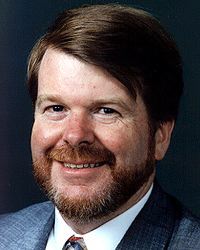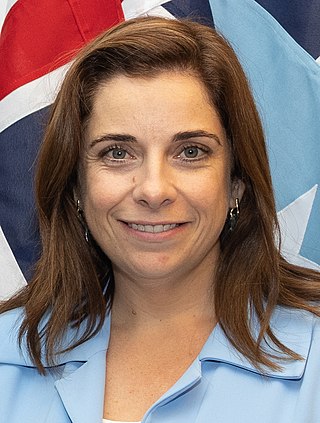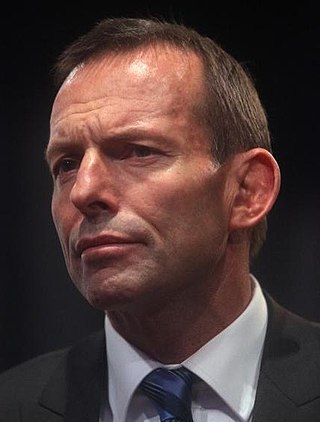
The prime minister of Australia is the head of government of the Commonwealth of Australia. By virtue of holding the confidence of the House of Representatives, they chair the Cabinet and thus head the federal executive government. The prime minister and their party also generally hold predominant legislative influence through their numbers in Parliament.

The House of Representatives is the lower house of the bicameral Parliament of Australia, the upper house being the Senate. Its composition and powers are set down in Chapter I of the Constitution of Australia.

A member of parliament (MP) is the representative in parliament of the people who live in their electoral district. In many countries with bicameral parliaments, this term refers only to members of the lower house since upper house members often have a different title. The terms congressman/congresswoman or deputy are equivalent terms used in other jurisdictions. The term parliamentarian is also sometimes used for members of parliament, but this may also be used to refer to unelected government officials with specific roles in a parliament and other expert advisers on parliamentary procedure such as the Senate parliamentarian in the United States. The term is also used to the characteristic of performing the duties of a member of a legislature, for example: "The two party leaders often disagreed on issues, but both were excellent parliamentarians and cooperated to get many good things done."

The Senate is the upper house of the bicameral Parliament of Australia, the lower house being the House of Representatives. The composition and powers of the Senate are established in Chapter I of the Constitution of Australia. There are a total of 76 senators: 12 are elected from each of the six Australian states regardless of population and 2 from each of the two self-governing internal Australian territories. Senators are popularly elected under the single transferable vote system of proportional representation.

The Parliament of Australia is the legislative body of the federal level of government of Australia. It consists of three elements: the monarch, the Senate and the House of Representatives. It combines elements from the UK Parliament and the US Congress.

The speaker of the House of Representatives is the presiding officer of the Australian House of Representatives, the lower chamber within the Parliament of Australia. The counterpart in the upper house is the president of the Senate. The office of the speakership was established in 1901 by section 35 of the Constitution of Australia. The primary responsibilities of the office is to oversee house debates, determine which members may speak, maintain order and the parliamentary and ministerial codes of conduct during sessions and uphold all rules and standing orders. The current speaker of the House of Representatives is Milton Dick, who was elected on 26 July 2022.

Parliament House, also referred to as Capital Hill or simply Parliament, is the meeting place of the Parliament of Australia, the legislative body of Australia's federal level of government. Located in Canberra, the Parliament building is situated on the southern apex of the Parliamentary Triangle atop Capital Hill, at the meeting point of Commonwealth, Adelaide, Canberra and Kings Avenue enclosed by the State Circle.
A crossbencher is a minor party member of some legislatures, such as the British House of Lords and the Parliament of Australia. They take their name from the crossbenches, between and perpendicular to the government and opposition benches, where crossbenchers sit in the chamber.

Henry Alfred "Harry" Jenkins, is a former Australian politician. He was a member of the House of Representatives from 1986 to 2013, representing the Australian Labor Party (ALP).
Elections in Australia take place periodically to elect the legislature of the Commonwealth of Australia, as well as for each Australian state and territory and for local government councils. Elections in all jurisdictions follow similar principles, although there are minor variations between them. The elections for the Australian Parliament are held under the federal electoral system, which is uniform throughout the country, and the elections for state and territory Parliaments are held under the electoral system of each state and territory.

The Minister for Finance in the Government of Australia is responsible for monitoring government expenditure and financial management. The current minister is Senator Katy Gallagher who has held the position since May 2022.
The Australian Government, also known as the Commonwealth Government, is the national government of the Commonwealth of Australia, a federal parliamentary constitutional monarchy. The executive government consists of the prime minister and other ministers that currently have the support of a majority of members of the House of Representatives and in some contexts also includes the departments and other executive bodies that ministers oversee. The current executive government consists of Anthony Albanese and other Australian Labor Party ministers, in place since the 2022 federal election.

In the Parliament of Australia, the Leader of the House is the government minister responsible for the management of government business in the House of Representatives, including the order in which the Government's agenda is to be dealt with, tactical matters in reaction to impediments to such management, negotiation with the Opposition's counterpart about the order in which bills are to be debated, and the time allotted for debates. The position is currently held by Tony Burke since June 2022.

The Minister for Health and Aged Care is the position in the Australian cabinet responsible for national health and wellbeing and medical research. The incumbent Minister is Labor MP Mark Butler.

The 2010 Australian federal election was held on Saturday, 21 August 2010 to elect members of the 43rd Parliament of Australia. The incumbent centre-left Australian Labor Party led by Prime Minister Julia Gillard won a second term against the opposition centre-right Liberal Party of Australia led by Opposition Leader Tony Abbott and Coalition partner the National Party of Australia, led by Warren Truss, after Labor formed a minority government with the support of three independent MPs and one Australian Greens MP.

In the Australian Government, the Minister for Sport is currently Anika Wells since 1 June 2022.

The 2013 Australian federal election to elect the members of the 44th Parliament of Australia took place on 7 September 2013. The centre-right Liberal/National Coalition opposition led by Opposition leader Tony Abbott of the Liberal Party of Australia and Coalition partner the National Party of Australia, led by Warren Truss, defeated the incumbent centre-left Labor Party government of Prime Minister Kevin Rudd in a landslide. It was also the third time in history that a party won 90 or more seats at an Australian election. Labor had been in government for six years since being elected in the 2007 election. This election marked the end of the Rudd-Gillard-Rudd Labor government and the start of the 9 year long Abbott-Turnbull-Morrison Liberal-National Coalition government. Abbott was sworn in by the Governor-General, Quentin Bryce, as Australia's new Prime Minister on 18 September 2013, along with the Abbott Ministry. The 44th Parliament of Australia opened on 12 November 2013, with the members of the House of Representatives and territory senators sworn in. The state senators were sworn in by the next Governor-General Peter Cosgrove on 7 July 2014, with their six-year terms commencing on 1 July.
This is a list of members of the Australian House of Representatives of the 43rd Parliament of Australia (2010–2013), as elected at the 2010 federal election.

Stephen Patrick Jones is an Australian politician who represents the Division of Whitlam for the Australian Labor Party. He was elected at the 2010 Australian federal election and is the current Assistant Treasurer and Minister for Financial Services.
The 43rd Canadian Parliament once again set a record number of female Members of Parliament, with 98 women elected to the 338-member House of Commons of Canada (28.9%) in the 2019 election. Of those 98 women, 31 were elected for the first time in the 2019 election. 2 more women were elected in by-elections in October 2020, reaching the historic milestone of 100 women in the House of Commons for the first time. This represents a gain of twelve seats over the previous record of 88 women in the 42nd Canadian Parliament. By contrast, the 116th United States Congress had 102 women sitting in the 435-seat United States House of Representatives (23.4%).









